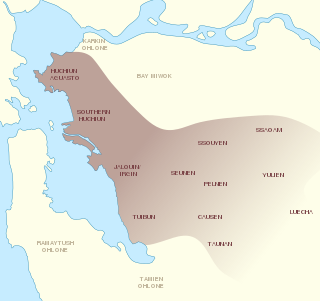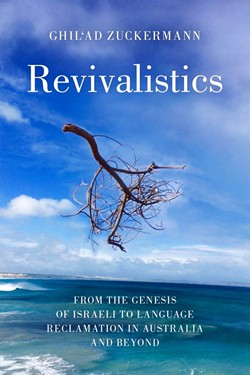
An extinct language is a language that no longer has any first-language or second-language speakers, especially if the language also has no living descendants. In contrast, a dead language is a language that no longer has any first-language speakers, but does have second-language speakers, such as Latin. A dormant language is a dead language that still serves as a symbol of ethnic identity to an ethnic group; these languages are often undergoing a process of revitalisation. Languages that have first-language speakers are known as modern or living languages to contrast them with dead languages, especially in educational contexts.

The Rumsen language is one of eight Ohlone languages, historically spoken by the Rumsen people of Northern California. The Rumsen language was spoken from the Pajaro River to Point Sur, and on the lower courses of the Pajaro, as well as on the Salinas and Carmel Rivers, and the region of the present-day cities of Salinas, Monterey and Carmel.
Language revitalization, also referred to as language revival or reversing language shift, is an attempt to halt or reverse the decline of a language or to revive an extinct one. Those involved can include linguists, cultural or community groups, or governments. Some argue for a distinction between language revival and language revitalization. There has only been one successful instance of a complete language revival, the Hebrew language, creating a new generation of native speakers without any pre-existing native speakers as a model.

In linguistics, language death occurs when a language loses its last native speaker. By extension, language extinction is when the language is no longer known, including by second-language speakers, when it becomes known as an extinct language. A related term is linguicide, the death of a language from natural or political causes, and, rarely, glottophagy, the absorption or replacement of a minor language by a major language.

The Tasmanian languages were the languages indigenous to the island of Tasmania, used by Aboriginal Tasmanians. The languages were last used for daily communication in the 1830s, although the terminal speaker, Fanny Cochrane Smith, survived until 1905.
Kaurna is a Pama-Nyungan language historically spoken by the Kaurna peoples of the Adelaide Plains of South Australia. The Kaurna peoples are made up of various tribal clan groups, each with their own parnkarra district of land and local dialect. These dialects were historically spoken in the area bounded by Crystal Brook and Clare in the north, Cape Jervis in the south, and just over the Mount Lofty Ranges. Kaurna ceased to be spoken on an everyday basis in the 19th century and the last known native speaker, Ivaritji, died in 1929. Language revival efforts began in the 1980s, with the language now frequently used for ceremonial purposes, such as dual naming and welcome to country ceremonies.

The Awaswas, also known as the Santa Cruz people, were a group of the Indigenous peoples of California in North America, with subgroups historically numbering about 600 to 1,400. Academic research suggests that their ancestors had lived within the Santa Cruz Mountains region for approximately 12,000 years. The Awaswas maintained regular trade networks with regional cultures before the Spanish colonists began settling in the area from the 18th century.

The Chochenyo are one of the divisions of the Indigenous Ohlone (Costanoan) people of Northern California. The Chochenyo reside on the east side of the San Francisco Bay, primarily in what is now Alameda County, and also Contra Costa County, from the Berkeley Hills inland to the western Diablo Range.
Palawa kani is a constructed language created by the Tasmanian Aboriginal Centre as a composite Tasmanian language, based on reconstructed vocabulary from the limited accounts of the various languages once spoken by the Aboriginal people of what is now Tasmania.

The Ohlone languages, also known as Costanoan, form a small Indigenous language family historically spoken in Northern California, both in the southern San Francisco Bay Area and northern Monterey Bay area, by the Ohlone people. Along with the Miwok languages, they are members of the Utian language family. The most recent work suggests that Ohlone, Miwok, and Yokuts are branches of a Yok-Utian language family.

Ghil'ad Zuckermann is an Israeli-born language revivalist and linguist who works in contact linguistics, lexicology and the study of language, culture and identity.

Barngarla, formerly known as Parnkalla, is an Aboriginal language of Eyre Peninsula, South Australia. It was formerly extinct, but has undergone a process of revival since 2012.
Chochenyo is the spoken language of the Chochenyo people. Chochenyo is one of the Ohlone languages in the Utian family.
Bruny Island Tasmanian, or Nuenonne ("Nyunoni"), a name shared with Southeast Tasmanian, is an Aboriginal language or pair of languages of Tasmania in the reconstruction of Claire Bowern. It was spoken on Bruny Island, off the southeastern coast of Tasmania, by the Bruny tribe.
Daryl Baldwin is an American academic and linguist who specializes in the Myaamia language. An enrolled member of the Miami Tribe of Oklahoma, Baldwin has served as a member of the cultural resource advisory committee of the Miami Tribe.

The Nauo people, also spelt Nawu and Nhawu, are an Aboriginal Australian people of the south-western Eyre Peninsula in South Australia. The Nauo language became extinct by the twentieth century, but efforts are being made to revive it.
Clamor Wilhelm Schürmann was a Lutheran missionary who emigrated to Australia and did fundamental pioneering work, together with his colleague Christian Gottlieb Teichelmann, on recording some Australian languages in South Australia.

Revivalistics: From the Genesis of Israeli to Language Reclamation in Australia and Beyond is a scholarly book written by linguist and revivalist Ghil'ad Zuckermann. It was published in 2020 by Oxford University Press. The book introduces revivalistics, a trans-disciplinary field of enquiry exploring "the dynamics and problematics inherent in spoken language reclamation, revitalization, and reinvigoration".

The Tasmanian Aboriginal Centre (TAC) is a human-rights and cultural organisation for Aboriginal Tasmanians. It was originally founded as the Tasmanian Information Centre in 1973 and has campaigned on land return, Aboriginal identity and return of stolen remains.














